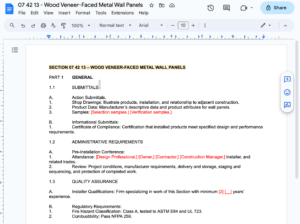Understanding Uniformat II
Uniformat II, also known as ASTM E1557, is a system used for classifying building elements and related sitework based on their functional characteristics, rather than the materials or products composing them. This classification system is organized around the physical parts of a facility, termed as systems and assemblies.
This standard was initially developed by ASTM International in 1989, and maintains consistency during the economic evaluation of building projects, both over time and across different projects. Moreover, it facilitates better project management and reporting throughout all stages of a building’s life cycle, which includes planning, design, construction, and operation phases.
Enhanced Communication
It provides a common language for all project stakeholders. This fosters better communication and understanding among different disciplines involved in the project, unlike a traditional 3-part specification format, which has a more segmented structure.
Cost Control and Budgeting
The groups elements based on functionality, which simplifies cost control and budgeting. This contrasts with 3-part specifications, which organizes elements by materials and work results. Uniformat II offers a more intuitive approach to managing project costs from the beginning.
Performance Analysis
By organizing specifications by building systems and assemblies, and facilitates performance analysis and life-cycle costing. This allows for a holistic evaluation of design alternatives based on long-term value and performance.
Sustainability Analysis
It also supports sustainability analysis by aligning with environmental impact evaluation and life-cycle assessment. This is crucial for modern construction projects aiming for environmental sustainability and compliance with green building standards.
Ease of Modification and Expansion
The elemental classification structure is flexible and adaptable to changing project requirements or new construction technologies. In contrast, the rigid structure of MasterFormat may struggle to accommodate changes or the inclusion of new categories.
Integration with Building Information Modeling (BIM)
Uniformat II’s elemental structure seamlessly integrates with Building Information Modeling (BIM). This integration enhances coordination, reduces errors, and improves overall project delivery by combining design, specification, and construction data in a unified modeling environment.
Uniformat II, with its elemental classification, offers a robust and flexible framework for organizing construction specifications. It enhances communication, enables better cost control, and supports sustainability and performance analysis, making it the superior choice for modern construction projects striving for efficiency, sustainability, and improved project delivery. Consider Uniformat II for your next construction project to harness these benefits and optimize your project’s success.
A few weblink to explore on Uniformat II:



